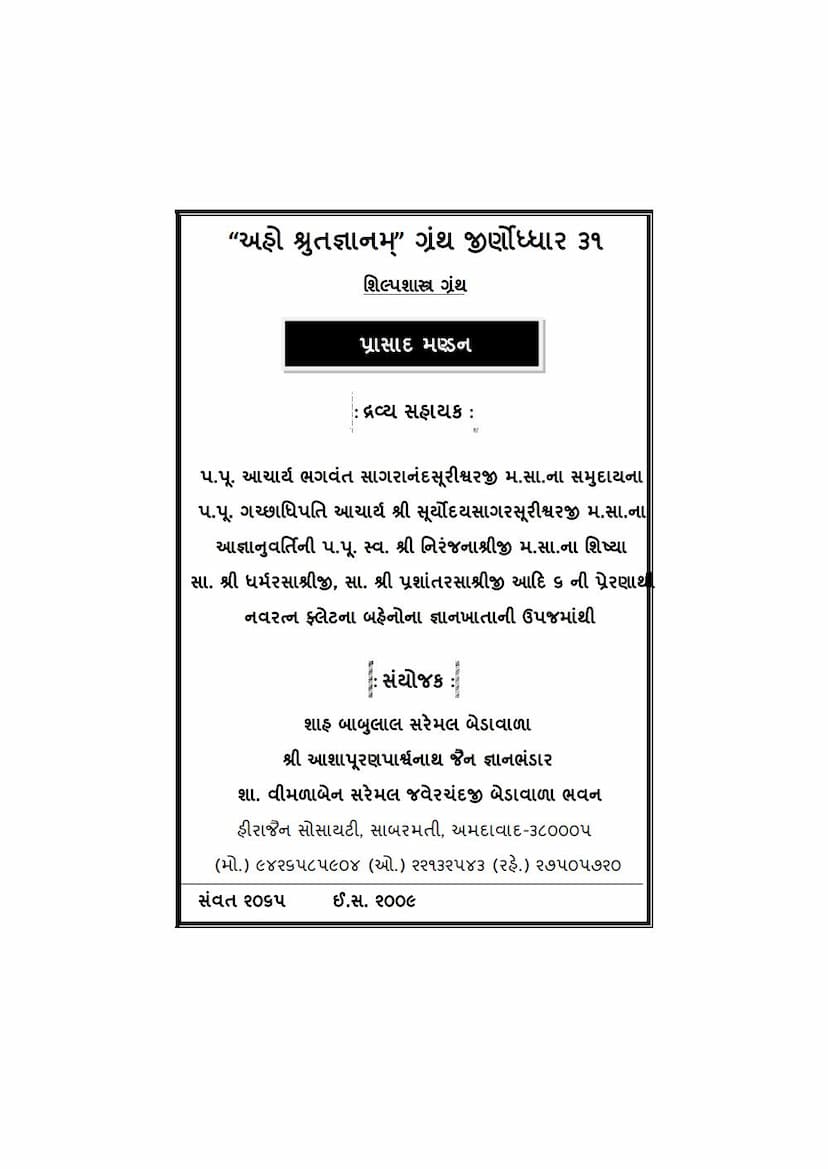Prasad Mandana
Added to library: September 2, 2025

Summary
The Jain text "Prasad Mandana" by Bhagwandas Jain (originally by Sutradhar Mandan) is a comprehensive treatise on Hindu temple architecture, translated and edited into Gujarati. This summary focuses on the content outlined in the provided text, which includes detailed discussions on various aspects of temple construction.
Core Subject:
"Prasad Mandana" is a foundational text in Vastu Shastra, focusing on the design and construction of temples ("Prasada"). It covers the theoretical and practical aspects of architecture, from the mythological origins of Vastu Purusha to the intricate details of ornamentation and construction.
Key Aspects Covered:
- Origin of Vastu: The text traces the origin of Vastu to a cosmic event involving Lord Shiva and a demon, from which the Vastu Purusha emerged.
- Temple Types and Classifications: It elaborates on the fourteen different types of temples based on their shapes (square, rectangular, circular, oval, octagonal) and their subsequent sub-classifications, leading to a vast number of temple variations.
- Reasons for Temple Construction: The book highlights the spiritual, societal, and royal benefits derived from constructing temples, such as achieving spiritual liberation, enhancing civic beauty, ensuring prosperity, and earning merit.
- Principles of Site Selection and Preparation: Detailed guidelines are provided for choosing appropriate land, conducting site examinations, and preparing the foundation, including rituals and considerations for the Vastu Purusha.
- Measurement and Proportions: The text emphasizes the importance of precise measurements and proportions for various temple components, including the foundation (Jagati), walls (Mandovar), sanctum (Garbha), pillars (Stambha), doors, and spires (Shikhara). It discusses the significance of the "Ayadi" calculations for auspiciousness.
- Architectural Elements: A significant portion is dedicated to describing specific architectural elements:
- Jagati (Adhishthana): The base or platform of the temple, its shapes, dimensions, and decorative features.
- Mandovar (Walls): The structure and layering of the walls, including different types of plinths and decorative moldings.
- Pillars (Stambha): Their design, proportions, and decorative elements.
- Doors and Entrances: Detailed specifications for door frames (Dwarashakha), including the number of decorative motifs (Shakha) and their placement, as well as the importance of the threshold (Udambara).
- Shikhara (Spires): The design principles, structural elements like Rekha (outline), Chandrakala Rekha, and various decorative features like Amalaka, Kalasha, and Shukanasa.
- Mandapa (Pavilions): Different types of pavilions, their construction, and their relationship to the main sanctum.
- Vitan (Ceilings/Domes): Various types of decorative ceilings and domes, including their construction and ornamentation.
- Mandala and Yantras: The use of cosmic diagrams and geometric patterns in temple design and construction.
- Surya Purusha: The concept and placement of the "Prasad Purusha" (life force of the temple).
- Dhvajadanda (Flag Mast): its placement and construction.
- Temple Styles: The text mentions and describes various regional temple styles, including Nagar, Dravida, Bhumija, Latina, Sāndhāra, Vimana-Nagar, and Mishrakas.
- Specific Temple Designs: It details the characteristics and construction of numerous specific temple types, including the 25 Vairajya-category Prasadas and the 9 Mahameru Prasadas, often mentioning the number of shringas (spires) and their configurations.
- Deity Placement and Iconography: Guidelines are provided for the placement of deities within the temple, the proportions of idols, and considerations regarding their orientation and sightlines (Drishti).
- Religious Rituals and Sanctity: The text touches upon rituals associated with temple construction, such as Vastu Puja, Shanti Puja, and the consecration (Pratishtha) of the deity. It also discusses the sanctity of temples and the merits of their construction and upkeep.
- Specific Architectural Debates and Clarifications: The translator, Pandit Bhagwandas Jain, often provides clarifications and critiques of existing interpretations of architectural texts, highlighting discrepancies and offering his reasoned explanations based on his expertise and study of ancient temples. He addresses issues like the correct interpretation of shlokas, the placement of certain architectural elements, and the potential inaccuracies in other published works.
- Materials: The text specifies the use of various materials for construction, including wood, clay, brick, stone, metal, and gems, with an emphasis on the increasing merit derived from using progressively finer materials.
Translator's Contribution:
Pandit Bhagwandas Jain's role as translator and editor is significant. He aimed to make this complex Sanskrit text accessible to a wider audience by providing a Gujarati translation, extensive commentary (known as "Subodhini"), and illustrative diagrams. His efforts were driven by a desire to present accurate and practical knowledge of Vastu Shastra, correcting perceived errors in previous publications and drawing upon his extensive experience as a scholar and observer of ancient temple architecture.
Overall Significance:
"Prasad Mandana," through its Gujarati translation and commentary, serves as a vital resource for understanding the principles and practices of ancient Indian temple architecture. It offers insights into the philosophy, symbolism, and technical expertise involved in creating sacred spaces, reflecting a deep integration of art, science, and spirituality in Indian tradition. The text is presented as a guide for sculptors and architects, encouraging adherence to established principles while acknowledging the potential for interpretation and refinement.